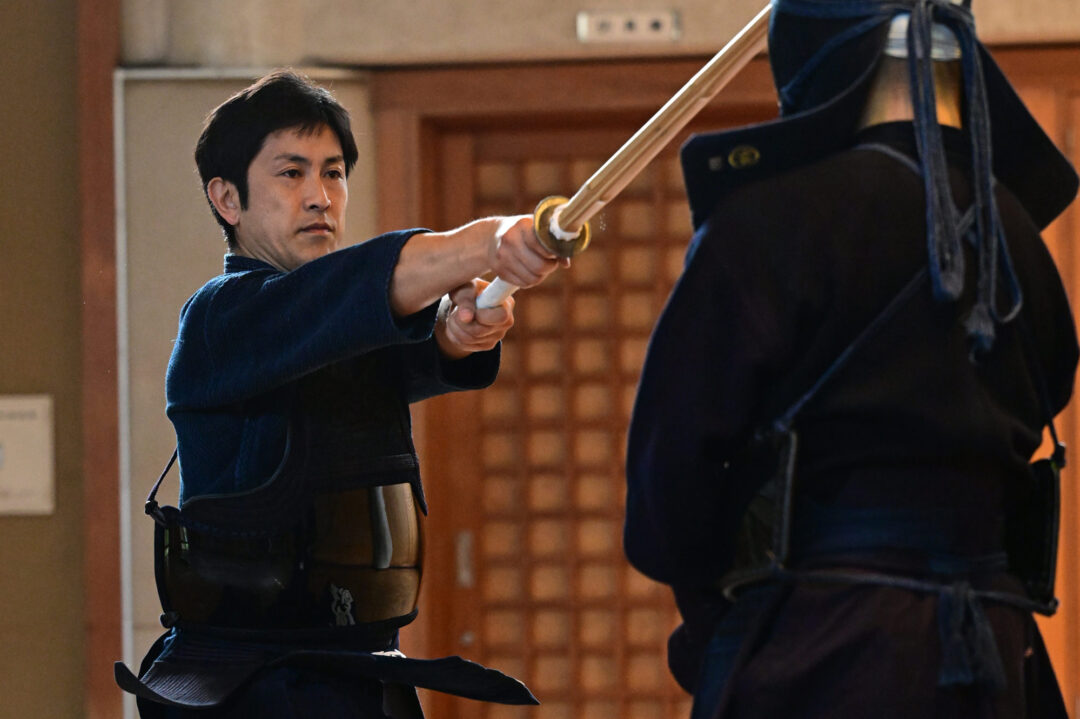2023.11 KENDOJIDAI
Photography: Nishiguchi Kunihiko
Translation: Jouke van der Woude
Takanabe Susumu, who has continued to be at the forefront of the All Japan Kendo Championship and the World Kendo Championships achieved success in his first attempt at the 8th Dan examination held in Nagoya in August of this year.
In the past few years of training, his focus has been on “winning before striking” in Kendo rather than “striking to win.” He has honed his Shikake-waza within this philosophy.
Takanabe Susumu, Kyoshi 8th Dan
Born in Kumamoto Prefecture in 1976. He progressed from PL Gakuen High School to the University of Tsukuba, and after graduating, served in the Kanagawa Prefectural Police. He has won the All Japan Kendo Championship title twice (back to back), three team titles and one individual title in the World Kendo Championships, team and individual titles in National Police Kendo Championships, and three titles at the All Japan Invitational 7th Dan Championship (Yokohama). Currently, he serves as the Chief Instructor within the Kanagawa Prefectural Police.

From a young age, I mostly engaged in Shiai focusing on Shikake-waza. Even now, these techniques are, of course, important to me.
During my training as a Tokuren member, I was still lacking in understanding how to make my opponent get disrupted in terms of the well known phrase “winning before striking”. However, as I became an instructor and aimed for higher dan levels, I started to consciously focus on these aspects in Kendo. I think this shift in mindset may have led to my success when undergoing the 8th Dan examination.
As I transitioned to practicing Kendo with the theme of winning before striking, I began to place importance on the process leading up to the strike.
I still do not fully comprehend the phrase “winning before striking” in terms of its actual manifestations, and I continue to experiment and learn.
In my case, I was originally not the type to employ aggressive Seme through the Kensaki. When using Shikake-waza In my younger days, I didn’t engage much in techniques like Osae-waza (suppressing the Shinai), Harai-waza, or Hari-waza (extending the arms for Shinai control) to the opponent’s Shinai. This was because matches among younger practitioners tended to have a wide Ma-ai between opponents, and the pace of the Shiai was fast. Consequently, the emphasis was often placed on physical capabilities to strike immediately upon entering Uchi-ma (striking distance) and the set-up for those situations.
However, regarding this style of Seme, I have received several comments from the instructors at the Kanagawa Prefectural Police to the effect that, especially recently, “because there is no disruption, it only appears as a mere hit.” Therefore, to focus more on disrupting my opponent, I’ve tried to incorporate more techniques which involve Shinai control in my regular Keiko, such as Osae-waza. For example, in Uchikomi-keiko and Kakari-geiko, I used to prioritize the momentum of the body, but I began to build up my strikes by consciously incorporating disruption and creating opportunities to execute techniques. Even if I recognized that I struck after disrupting the opponent and would get countered, I made it a point to follow through with my technique and pass my opponent.
The idea is to manifest Shikai (any of the negative emotions of surprise, fear, doubt, or confusion) in the opponent before striking, to alert them. To catch the moment when they are slightly disrupted. In encounters between high-ranking practitioners, I think it’s less likely to have a significant disruption. Therefore, I focus on utilizing even the slightest disruption. While I think it’s challenging to completely disrupt the opponent, I made efforts to create as little as a 10% disruption to an opponent who is 100% prepared with the intent to strike with about 120% power.
For example, in footwork during mutual Seme, I made an effort not to make unnecessary movements and aimed for footwork which allowed me to use full force when I felt it was the right moment to strike. The idea is transitioning from stillness to motion in an instant. Since the 8th Dan examination is conducted according to age groups, I particularly focused on strengthening my legs and lower body. Furthermore, I focused on following through with my strikes to generate momentum after the strike.
I believe that doing Keiko with this kind of awareness leads to disrupting the opponent through Seme, win, and following through with strikes and I am still working on that.
To perform Shikake Waza, first create a potent state
The rest of this article is only available for Kendo Jidai International subscribers!



